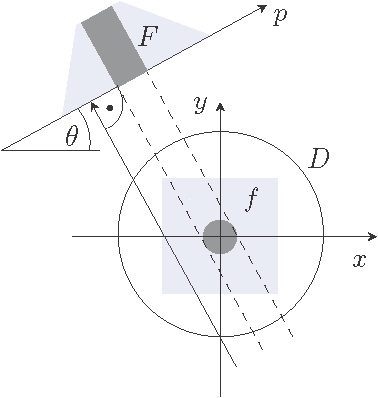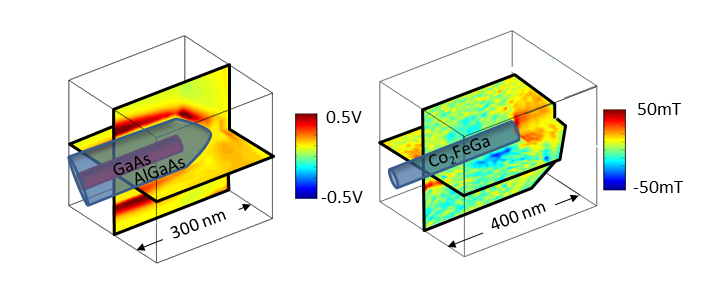IT-10-P-1904 Electron Holographic Tomography of Electric and Magnetic Stray Fields around Nanowires
One important consequence of the support theorem of the Radon transformation is that the so-called outer Radon problem (ORP), stating that the tomographic reconstruction of a scalar function in the exterior of a convex domain from projections along submanifold passing outside that domain, has a unique solution. Cast into the specific circumstances of electron holographic tomography that means that a reconstructed phase tilt series from outside a charged nanostructure, such as a nanowire (NW), is sufficient to reconstruct the corresponding potential in that outer region (Fig. 1). The topic of this contribution is the solution of the ORP, including its technical implementation and benefits for the determination of physical quantities within the framework of electron holographic tomography. Until now, only the interior Radon problem, i.e. the reconstruction of potentials within a convex (circular) domain containing e.g. a pn-junction has been treated. There, a number of issues which can be potentially tackled with the help of the ORP have been encountered: (A) Tilt angles within the TEM are often limited to within approx. -70° to 70°, rendering spatial frequencies in the corresponding missing wedge in Fourier space inaccessible. (B) Phase unwrapping algorithms cannot distinguish between unresolved phase gradients larger then π and phase jumps, producing artefacts at object boundaries (e.g. at FIB prepared specimen). (C) During tilting the proximity of a low-index zone axis can lead to dynamical scattering. (D) Magnetic field reconstruction suffers from the difficult alignment of 2 by 180° flipped tilt series required to seperate electric and magnetic phase shifts. The lowered influence of these issues in the ORP is of course purchased by disregarding any information from the blocked specimen region. However, the laws of electro-(magneto)statics relate the outside potentials to object charges and dipoles, thus rendering the fringing fields a valuable property. We will demonstrate a solution to the ORP including its potential to mitigate the above issues by reconstructing a small beam induced charging field around a core-shell GaAs-AlGaAs NW (Fig. 2) and a magnetic field emerging from the tip of a Co2FeGa Heusler alloy NW (Fig. 2) into vacuum. Both fields are very weak and could only partially recovered by means of the interior Radon problem due to the above issues.
The authors acknowledge financial support from the European Union under the Seventh Framework Program under a contract for an Integrated Infrastructure Initiative. Reference 312483 - ESTEEM2.

